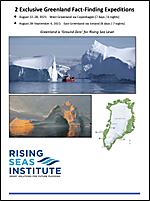Why Greenland is “Ground Zero”
Why does Greenland command the world’s attention? Because it’s the key to gauging future global sea level rise. It’s where the fastest melting ice is…
Like Willie Sutton supposedly said when asked why he robbed banks: “That’s where the money is.”
Even with the minor size distortion shown in this image from Google maps, its immense size is obvious. Greenland north to south is comparable to the United States from Maine to Florida – and it’s about as wide as the U.S. east of the Mississippi. Greenland is the twelfth largest nation in land area and the largest island. With only 56,000 residents spread over a few dozen coastal communities, it is the least densely populated country.
It’s special feature is obvious by the map coloration: white, representing the ice sheet, covering about 80% of the total area, as it has for millions of years. The ice sheet is over a mile thick. If it all were to melt, global sea level would rise more than 7.5 meters, about 25 feet. Though there is virtually no chance for that to happen any time soon, even a few feet (~ a meter) of global sea level rise this century would be catastrophic…and that is now quite possible.
Though Antarctica has seven times more ice, Greenland is melting much, much faster than Antarctica. The Arctic is warming at approximately three times the global average. Without getting technical, suffice to say that the tilt of the Earth, the placement of the continents, and ocean and atmospheric currents all bring more of the excess heat to the Arctic.
Greenland is also on my mind this week because we are organizing two “Fact-Finding Expeditions” there for August, 2021. Having led many such trips to Greenland and to Antarctica, I prefer Greenland. Travel is much easier and less expensive.
But more importantly, you can actually see the mega-glaciers, the vast ice sheet, the calving icebergs, and the rivers of meltwater much more clearly than in Antarctica. In Greenland, you see it and experience it up close. In Antarctica, mostly from afar.
The fact that Greenland actually has some historic communities and a rich history intertwined with the Arctic also adds greatly to its appeal as a destination.
In contrast, Antarctica only has a few research stations and no real citizens and residents.
These fact finding trips are oriented towards journalists, writers, photographers and those who can communicate the profound change now happening and getting worse every year that I visit. But frankly it’s the size and scale of the ice sheet that has to be seen to be grasped. My trips have also included a wide range of others willing to make the journey, including engineers, investors, attorneys, and military leaders. If you or someone you know might be interested, please send an email to greenland2021@johnenglander.net for full information. SPACE IS EXTREMELY LIMITED.
At present Greenland ice-melt is only amounting to fractions of an inch (millimeters) of global sea level rise. But it’s the acceleration rate that has us worried. Over the last three decades, the annual volume of melting ice increased seven times. From the geologic record we know that global sea level can rise more than fifteen feet (~5 meters) a century. The last time that happened was about eleven thousand years ago. With our rapid rise in warming, we are in “uncharted territory.”
We tend to believe that the stable sea level of the last six thousand years is normal – and will last. That would be a colossal mistake. As I described in the last two blog posts, even the noble effort to re-join the Paris Climate Accord will not stop sea level from rising. To be ready for the future, we all need to get educated and to inform others.
To view or download the Expedition Brochure, click here.
Looking at the News This Week… Massive Glacier Slide In India
A glacier high in the Himalaya mountains was in the news this weekend. A chunk of ice broke off, fell into a river, destroyed a dam, flooded a town in India and killed an estimated 170 people. Eventually that water will most likely find its way to the ocean, where it will technically raise sea level, though the amount will be minuscule and not noticeable. An Indian official was quoted: “This was clearly a climate impact.”
The relevant point, however, is that glaciers all over the world are being affected by the warming, some in profound ways. Though 98% of the world’s glaciers and ice sheets are in Antarctica and Greenland, those other two percent should not be overlooked. In fact, glacier melt in western North America, South America, and Asia presents very real problems with very serious consequences.
Glaciers might be thought of as multi-year water storage. They are critical to agriculture as they feed rivers and aquifers, particularly in the warmer times of year. As the glaciers melt and collapse, as evidenced by this one the other day in India, they will cause an excess of water, with flooding in various forms. But as they melt and disappear, they will soon cause a water shortage. This will have devastating effects in all regions where they now exist, mostly downstream in fertile areas.
To see the video story on CNN: https://www.cnn.com/videos/world/2021/02/07/india-flood-video-uttarakhand-glacier-orig-kj.cnn/video/playlists/around-the-world/



